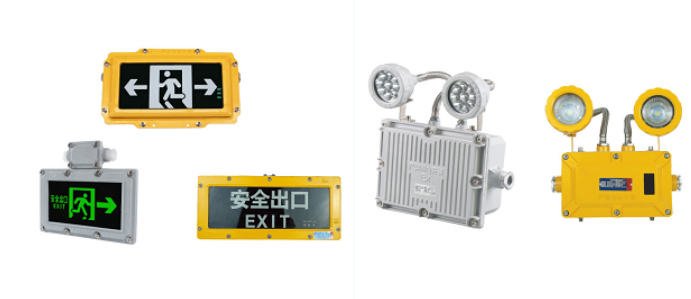Flame proof emergency light in chemical plant lighting application
Introduction: Chemical Plant Lighting Specialties and Safety Requirements
Chemical plant is a high-risk operating environment, flammable and explosive substances, complex piping systems and chemical reaction processes on the lighting equipment to put forward stringent requirements.
Ordinary lighting fixtures can not meet the safety needs of such scenes, and flame proof emergency light by virtue of its explosion-proof, high-temperature resistant, intelligent emergency features, etc., into the protection of personnel safety and production continuity of the core equipment.
In this paper, in-depth analysis of flame proof emergency light in chemical plants in the application of value, for the enterprise supply compliance, efficient lighting solutions.
First, why chemical plants must use special flame proof emergency light?
To cope with the flammable and explosive environment in chemical plants, volatile gases, dust and other hazardous substances are very likely to cause explosions or fires.
Ordinary lamps and lanterns electric sparks or high temperature surface probably become ignition source, and flame proof emergency light using explosion-proof shell, explosion-proof design, approved by the international certification [such as ATEX, IECEx], can be effectively isolated from the internal circuit and the external hazardous environment, to avoid accidents triggered.
Ensure emergency escape and rescue sudden power outage or fire, the conventional lighting system is probably paralyzed. flame proof emergency light built-in high-capacity batteries, can be automatically switched after the main power interruption, supply ≥ 90 minutes of emergency lighting, clear identification of escape routes, safety exits and the location of firefighting equipment, for the evacuation of personnel, rescue for the golden time.
Comply with stringent regulatory requirementsThe global chemical industry needs to comply with NFPA, OSHA, GB17945 and other safety guidelines, mandating that hazardous areas be equipped with explosion-proof certified emergency lighting equipment.
flame proof emergency light approved compliance design and certification, to help companies avoid legal risks and improve safety management rating.
Second, the core functions and technical advantages of flame proof emergency light
1. Explosion-proof and corrosion-resistant design
Material upgrading: the lamp body is made of die-casting aluminum or stainless steel, with protection level up to IP66, resisting chemical gas corrosion and high-pressure water rinsing.
Improved heat dissipation: High-efficiency heat dissipation structure reduces the surface temperature to avoid high temperature ignition of the surrounding materials.
2. Intelligent control and self-test system
Real-time monitoring: the built-in chip automatically detects the battery status and light source life, triggers an alarm and pushes it to the control center when it fails.
Remote management: With the integration of Internet of Things [IoT], centralized monitoring and energy efficiency analysis of the status of multi-region lamps and lanterns.
3. Long battery life and high brightness output
Lithium technology: equipped with lithium iron phosphate batteries, cycle life of more than 2000 times, -20 ℃ to 60 ℃ environment stable operation.
Directional lighting: LED light source luminous efficacy>120lm/W, with wide-angle lens, covering the escape path and equipment operation area.
Third, the chemical plant flame proof emergency light selection guide
1. Regional risk level matching
Zone 0/1 〔high risk〕: choose explosion-proof 〔Ex d〕 fire emergency lamps, applicable to the continuous existence of explosive gas areas.Zone 2 〔medium risk〕: can choose increased safety 〔Ex e〕 or intrinsic safety 〔Ex ia〕, to reduce the cost and ensure the safety at the same time.Zone 2 〔medium risk〕: can choose increased safety 〔Ex e〕 or intrinsic safety 〔Ex ia〕, to reduce the cost and ensure the safety at the same time.
2. Installation Scenario Adaptation
Indoor tank/pipe layer: Choose wall-mounted or boom-type fixtures, which are vibration-resistant and easy to be adjusted at various angles. Open-air installation area: Prefer dustproof and waterproof models, with additional anti-UV coating to prevent shell aging.
3. Energy efficiency and maintenance costs
Choose the product with “constant light + emergency” dual mode, can be used as daily work lighting, reduce additional power consumption. Modular design lamps and lanterns can be high-speed replacement of batteries or light source components, reducing long-term maintenance costs.
Fourth. Successful cases: flame proof emergency light in the chemical park practical applications
A large petrochemical park in upgrading the lighting system, the deployment of more than 3,000 sets of intelligent flame proof emergency lamp, the implementation of the following results:
Safety Improvement: No lighting-related safety accidents for 3 consecutive years, approved EHS audit;
Efficient operation and maintenance: remote self-test system reduces 80% of manual inspection workload;
Cost savings: LED + lithium program to reduce annual energy costs by about 35%.
Fifth. Maintenance and testing: extend the life of flame proof emergency light fundamental
Monthly testing: manually start the emergency mode, verify the battery life and brightness.
Annual maintenance: clean the light body heat sinks, test the circuit sealing, and replace the aging parts.
Record Traceability: Approve the digital platform to archive each test result and generate a compliance report.
FAQ: Frequently Asked Questions about flame proof emergency light
Q: Do flame proof emergency light require regular battery replacement?
A: Yes, it is advocated to replace the batteries every 3-5 years [depending on the frequency of application] to ensure reliable operation in emergency situations.
Q: What is the difference between explosion-proof certification and fire certification?
A: Explosion-proof certification [such as ATEX] for explosion-proof performance, fire certification focuses on material flame retardancy, chemical plants need both products.
Q: Can I add flame proof emergency light to my existing lighting system?
A: Yes, but you need to ensure that the circuit is independent and meets the requirements of explosion-proof zoning, and advocate the design and installation by a professional team.







